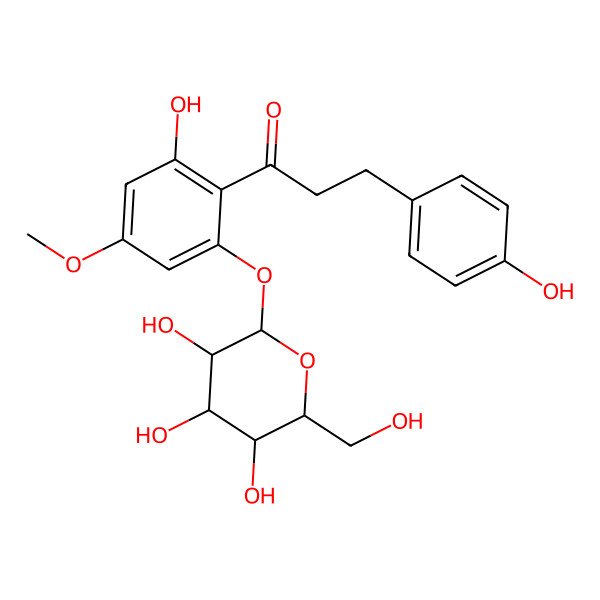CID 12308643
| Internal ID | ecf879d2-5bbd-448a-a7ee-7d35a9ca83b7 |
| Taxonomy | Phenylpropanoids and polyketides > Flavonoids > Flavonoid glycosides > Flavonoid O-glycosides |
| IUPAC Name | 1-[2-hydroxy-4-methoxy-6-[3,4,5-trihydroxy-6-(hydroxymethyl)oxan-2-yl]oxyphenyl]-3-(4-hydroxyphenyl)propan-1-one |
| SMILES (Canonical) | COC1=CC(=C(C(=C1)OC2C(C(C(C(O2)CO)O)O)O)C(=O)CCC3=CC=C(C=C3)O)O |
| SMILES (Isomeric) | COC1=CC(=C(C(=C1)OC2C(C(C(C(O2)CO)O)O)O)C(=O)CCC3=CC=C(C=C3)O)O |
| InChI | InChI=1S/C22H26O10/c1-30-13-8-15(26)18(14(25)7-4-11-2-5-12(24)6-3-11)16(9-13)31-22-21(29)20(28)19(27)17(10-23)32-22/h2-3,5-6,8-9,17,19-24,26-29H,4,7,10H2,1H3 |
| InChI Key | PQCIBORQLVRFMR-UHFFFAOYSA-N |
| Popularity | 4 references in papers |
| Molecular Formula | C22H26O10 |
| Molecular Weight | 450.40 g/mol |
| Exact Mass | 450.15259702 g/mol |
| Topological Polar Surface Area (TPSA) | 166.00 Ų |
| XlogP | 0.90 |
| 11075-15-3 |
| SCHEMBL10429626 |
| LMPK12120542 |
| 1-[2-hydroxy-4-methoxy-6-[3,4,5-trihydroxy-6-(hydroxymethyl)oxan-2-yl]oxyphenyl]-3-(4-hydroxyphenyl)propan-1-one |

| Target | Value | Probability (raw) | Probability (%) |
|---|---|---|---|
| No predicted properties yet! | |||
Proven Targets:
| CHEMBL ID | UniProt ID | Name | Min activity | Assay type | Source |
|---|---|---|---|---|---|
| No proven targets yet! | |||||
Predicted Targets (via Super-PRED):
| CHEMBL ID | UniProt ID | Name | Probability | Model accuracy |
|---|---|---|---|---|
| CHEMBL3251 | P19838 | Nuclear factor NF-kappa-B p105 subunit | 98.49% | 96.09% |
| CHEMBL5619 | P27695 | DNA-(apurinic or apyrimidinic site) lyase | 98.12% | 91.11% |
| CHEMBL3060 | Q9Y345 | Glycine transporter 2 | 95.57% | 99.17% |
| CHEMBL2581 | P07339 | Cathepsin D | 92.62% | 98.95% |
| CHEMBL2635 | P51452 | Dual specificity protein phosphatase 3 | 91.26% | 94.00% |
| CHEMBL3401 | O75469 | Pregnane X receptor | 91.00% | 94.73% |
| CHEMBL4203 | Q9HAZ1 | Dual specificity protein kinase CLK4 | 90.75% | 94.45% |
| CHEMBL4208 | P20618 | Proteasome component C5 | 89.60% | 90.00% |
| CHEMBL1293249 | Q13887 | Kruppel-like factor 5 | 89.12% | 86.33% |
| CHEMBL1907603 | Q05586 | Glutamate NMDA receptor; GRIN1/GRIN2B | 87.92% | 95.89% |
| CHEMBL3108638 | O15164 | Transcription intermediary factor 1-alpha | 86.93% | 95.56% |
| CHEMBL3091268 | Q92753 | Nuclear receptor ROR-beta | 86.58% | 95.50% |
| CHEMBL5608 | Q16288 | NT-3 growth factor receptor | 84.65% | 95.89% |
| CHEMBL5852 | Q96P65 | Pyroglutamylated RFamide peptide receptor | 83.23% | 85.00% |
| CHEMBL4793 | Q86TI2 | Dipeptidyl peptidase IX | 82.86% | 96.95% |
| CHEMBL4016 | P42262 | Glutamate receptor ionotropic, AMPA 2 | 82.67% | 86.92% |
| CHEMBL1075094 | Q16236 | Nuclear factor erythroid 2-related factor 2 | 82.66% | 96.00% |
| CHEMBL3437 | Q16853 | Amine oxidase, copper containing | 82.34% | 94.00% |
| CHEMBL2535 | P11166 | Glucose transporter | 80.85% | 98.75% |
| CHEMBL1860 | P10827 | Thyroid hormone receptor alpha | 80.74% | 99.15% |
| CHEMBL1806 | P11388 | DNA topoisomerase II alpha | 80.31% | 89.00% |
| CHEMBL3137262 | O60341 | LSD1/CoREST complex | 80.25% | 97.09% |
Below are displayed all the plants proven (via scientific papers) to contain this
compound!
To see more specific details click the taxa you are interested in.
To see more specific details click the taxa you are interested in.
| Guibourtia tessmannii |
| Kalmia latifolia |
| Kalmia polifolia |
| Kalmia procumbens |
| Pieris japonica |
| Saussurea mongolica |
| PubChem | 12308643 |
| LOTUS | LTS0082948 |
| wikiData | Q104252763 |